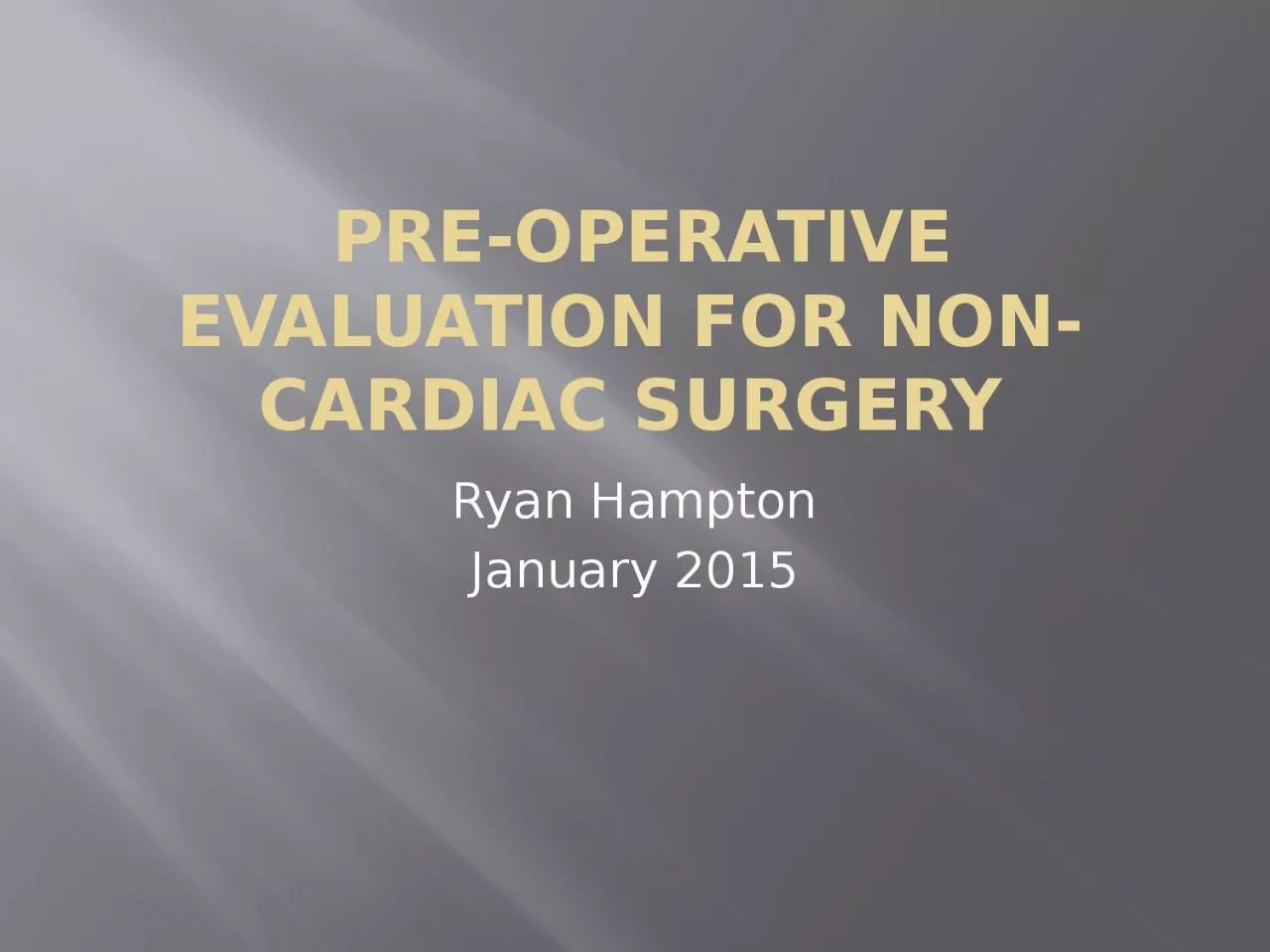

Ryan Hampton January 2015 Considerations Risks and benefits of surgery Timing of surgery Type of Surgery Goal is to uncover undiagnosed problems or treat prior conditions previously suboptimally treated ID: 935536
Download Presentation The PPT/PDF document "Pre-operative evaluation for non-cardiac..." is the property of its rightful owner. Permission is granted to download and print the materials on this web site for personal, non-commercial use only, and to display it on your personal computer provided you do not modify the materials and that you retain all copyright notices contained in the materials. By downloading content from our website, you accept the terms of this agreement.
Slide1
Pre-operative evaluation for non-cardiac surgery
Ryan Hampton
January 2015
Slide2Considerations
Risks and benefits of surgery
Timing of surgery
Type of Surgery
Goal is to uncover undiagnosed problems or treat prior conditions previously sub-optimally treated.
Slide3Algorithm
Slide4Perioperative Complications
Myocardial Infarction
Heart Failure
Ventricular Fibrillation
Cardiac Arrest
Complete Heart Block
Cardiac Death
Slide5Models for Risk Assessment
Revised Cardiac Risk Index (RCRI)
American College of Surgeons’ National Surgical Quality Improvement Program (ACS-NSQIP) risk calculator
Gupta MI or cardiac arrest (MICA) calculator
These calculators generate risk as a percent
Slide6Slide7Initial Preoperative Evaluation
Subjective
PMH: DM2, CKD, HTN, CVA, PAD
ROS: angina,
dyspnea
, syncope, palpitations
Cardiac Functional Status
Expressed in metabolic equivalents (METs)
1 MET = 3.5
mL
O2 uptake/kg/min
Can use equivalent functions to determine METs
Eg
: if patient can take care of self = 1 MET
Eg
: can participate in strenuous sports = >10 METs
Slide8Initial Preoperative Evaluation
Functional Status Threshold
Important Indicator: does patient’s cardiac function allow him/her to climb two flights of stairs or walk four blocks
Objective
Blood pressure
Auscultation of heart and lungs
Abdominal exam
Extremity exam for edema and vascular integrity
EKG for known CV disease
Limited utility in asymptomatic patient
Not part of RCRI or NSQIP criteria due to lack of prognostic specificity
However, routinely obtained pre-op for baseline comparison
Slide9Risk Factors Used in Prediction Models
History of ischemic heart disease
History of heart failure
History of CVA
Insulin dependent DM
Pre-op serum Cr >2.0
American Society of Anesthesiologist’ class
Pre-operative functional status
Increasing age
Atrial
Fibrillation*
Obesity*
*Not used in prediction models
Slide10American Society of Anesthesiologists Class
Slide11BUT…
POISE Trial (
Perioperative
Ischemic Evaluation)
8351 patients at high risk for or with atherosclerosis undergoing non-cardiac surgery
35 (0.4%) required coronary revascularization post-operatively
So, value of risk prediction models may be waning
Slide12Estimating Perioperative
Risk
Information from assessment combined with risk associated with the surgery is used to estimate
perioperative
risk of adverse cardiac events.
Risk Determines:
If surgery can proceed without further CV testing
If stress testing, echo, 24-hour ambulatory monitoring, changing plan of surgery to decrease risk, or canceling surgery so coronary revascularization can be performed is necessary
Slide13Gupta MICA NSQIP Risk Model
Used to determine risk factors associated with
intraoperative
/ postoperative MI or cardiac arrest (MICA)
Among 200,000 patients undergoing surgery in 2007, 0.65% developed
perioperative
MICA
5 Factors Contributing to MICA
Type of Surgery
Dependent Functional Status
Abnormal
Creatinine
ASA Class
Increased Age
Slide14Patient Stratification
Low Risk Patients
Estimated risk of death is less than 1 percent
No additional CV testing is required
Higher Risk Patients
Risk of death is 1% or higher
May require additional CV evaluation
Often, known CAD or
valvular
heart disease
Slide15Further Cardiac Testing
Stress testing
Not indicated in
perioperative
patient solely because of the surgery if there is no other indication
Patients with moderate to good function (>4 – 10 METs), reasonable to forego further testing
May be considered for patients undergoing elevated risk procedure in whom functional capacity is unknown if management will be affected (Level of Evidence: B)
Indicated with elevated risk and <4 METs or unknown functional capacity
Resting Echocardiography
Not indicated in the
perioperative
patient unless there is another indication (
eg
: murmur, valve function, LVEF, etc.)
Slide16Preoperative Coronary Angiography
Routine preoperative coronary angiography NOT recommended – insufficient data to support coronary angiography in all patients